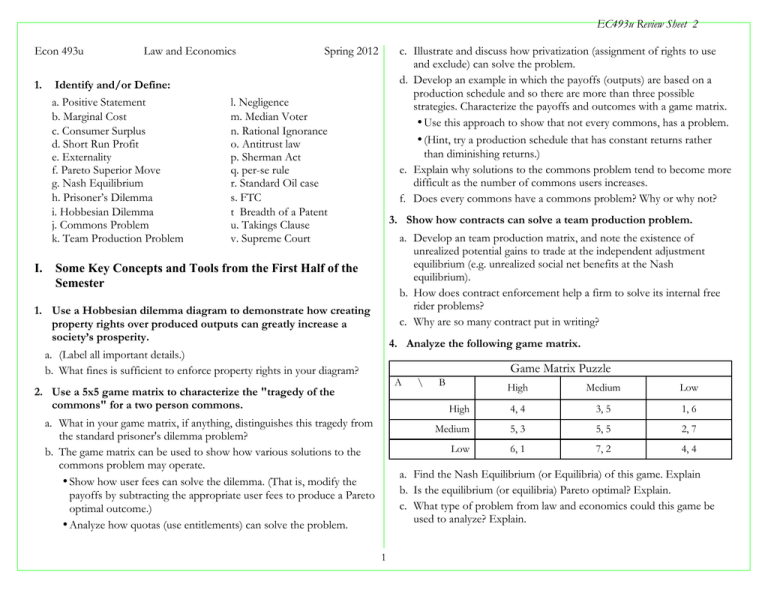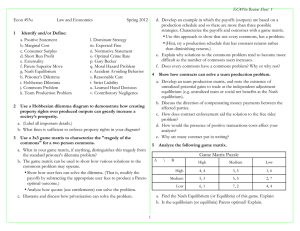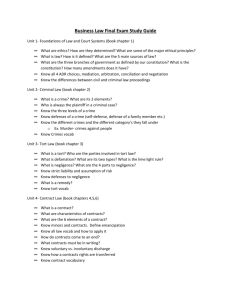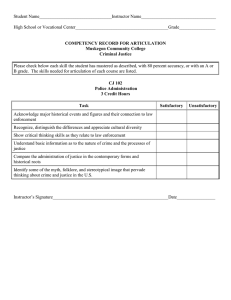Econ 493u Law and Economics Spring 2012
advertisement

EC493u Review Sheet 2 Econ 493u 1. I. Law and Economics Identify and/or Define: a. Positive Statement b. Marginal Cost c. Consumer Surplus d. Short Run Profit e. Externality f. Pareto Superior Move g. Nash Equilibrium h. Prisoner’s Dilemma i. Hobbesian Dilemma j. Commons Problem k. Team Production Problem c. Illustrate and discuss how privatization (assignment of rights to use and exclude) can solve the problem. d. Develop an example in which the payoffs (outputs) are based on a production schedule and so there are more than three possible strategies. Characterize the payoffs and outcomes with a game matrix. wUse this approach to show that not every commons, has a problem. w(Hint, try a production schedule that has constant returns rather than diminishing returns.) e. Explain why solutions to the commons problem tend to become more difficult as the number of commons users increases. f. Does every commons have a commons problem? Why or why not? Spring 2012 l. Negligence m. Median Voter n. Rational Ignorance o. Antitrust law p. Sherman Act q. per-se rule r. Standard Oil case s. FTC t Breadth of a Patent u. Takings Clause v. Supreme Court 3. Show how contracts can solve a team production problem. a. Develop an team production matrix, and note the existence of unrealized potential gains to trade at the independent adjustment equilibrium (e.g. unrealized social net benefits at the Nash equilibrium). b. How does contract enforcement help a firm to solve its internal free rider problems? c. Why are so many contract put in writing? Some Key Concepts and Tools from the First Half of the Semester 1. Use a Hobbesian dilemma diagram to demonstrate how creating property rights over produced outputs can greatly increase a society’s prosperity. 4. Analyze the following game matrix. a. (Label all important details.) b. What fines is sufficient to enforce property rights in your diagram? Game Matrix Puzzle A 2. Use a 5x5 game matrix to characterize the "tragedy of the commons" for a two person commons. a. What in your game matrix, if anything, distinguishes this tragedy from the standard prisoner's dilemma problem? b. The game matrix can be used to show how various solutions to the commons problem may operate. wShow how user fees can solve the dilemma. (That is, modify the payoffs by subtracting the appropriate user fees to produce a Pareto optimal outcome.) wAnalyze how quotas (use entitlements) can solve the problem. \ B High Medium Low High 4, 4 3, 5 1, 6 Medium 5, 3 5, 5 2, 7 Low 6, 1 7, 2 4, 4 a. Find the Nash Equilibrium (or Equilibria) of this game. Explain b. Is the equilibrium (or equilibria) Pareto optimal? Explain. c. What type of problem from law and economics could this game be used to analyze? Explain. 1 EC493u Review Sheet 2 5. Depict a potential law breakers choice of personal “crime rate.” b. Are there any differences between negligence and contributory negligence rules? c. In what sense can negligence and contributory negligence rules be said to be superior to a strict liability rule in this context? a. Note all relevant details. b. What is the law-breaker’s net benefit from this crime? c. Show the effect on an increase in expected penalties on the crime rate selected by this person. d. How would one create a supply (or demand) curve for criminal activities? [Hint: the expected fine can be thought of as the price of illegal activities.] 9. Depict the optimal level of care for damages associated with three types of accident: no causality, one way causality, joint causality. Label all important details. a. Is there an assignment of damages from accidents that produces the ideal level of care in all cases? b. What liability rules work best for each setting? Discuss. c. Is there any reason to treat accidents differently from crimes that impose similar damages? Explain. d. How would the systematic over assessment of damages by the courts affect your analysis? 6. Create a diagram or series of diagrams that demonstrate that the optimal crime rate is NOT zero. a. b. c. d. e. Explain the logic of these diagrams. What factors tend to increase the optimal level of crime? What factors tend to decrease the optimal level of crime? How would an increase in average age increase the crime rate? Crime rates have been falling in the US for the past 20 years, are their any factors that suggest that such reductions have been “optimal.” II. New Tools and Extensions of Old Tools Covered in the Second Half of the Semester 7. Illustrate a moral hazard problem (under-investment in care problem) and show how tort law can induce people to take greater care than they would have without tort law? 1. Discuss briefly the difference between the strong and weak forms of the median voter theorem. a. Label all important details. b. What assumption about causality have you made? c. What incentive does the modeled individual have to take steps to reduce the probability of an accident without tort law? d. What is the normative problem associated with a person’s decisions to “take care” in the absence of tort law? e. How does tort law change a person’s incentives to exercise due care? 2. Use a distribution of voter ideal points curve to conduct a series of elections that demonstrates why candidate policy positions tend to converge toward the median voter’s ideal point. 3. Draw a diagram in which three persons have different MB curves for expenditures on law enforcement. Assume that each person faces the same marginal cost schedule. a. Characterize each person’s ideal point. b. Characterize a democratic government’s budget for law enforcement using the median voter theorem. Briefly explain your reasoning. c. Show what happens to law enforcement budgets if each person believes that the risk of crime (i) have increased, (ii) have decreased? 8. Use a game matrix to illustrate how strict liability, negligence, and contributory negligence rules affect levels of care in a setting where both the accident causer (tort feasor) and victim can affect the extent of the damages by exercising “care.” a. Explain the problem associated with strict liability rules in this setting. 2 EC493u Review Sheet 2 7. Use a conventional diagram to characterize the advantage of competitive markets over monopolistic ones. d. Now suppose that two of the three voters have a higher MC (tax cost) for law enforcement than the other. How does this change your results? a. Label all details including the ordinary deadweight loss of monopoly (H). b. Discuss why monopoly profits may be dissipated through non-price forms of competition or through contests to obtain government favors. c. If “b” occurs, characterize the full deadweight loss from monopoly. d. What, if anything, does “c” imply about the optimal level of antitrust law enforcement relative to that implied by “a.” e. Use a diagram of optimal law enforcement to support your answer to “d.” [Hint, this will look a lot like the optimal law enforcement diagram for ordinary crimes developed in the first part of the course.] 4. Use expected marginal benefit and cost curves to illustrate the problem of rational ignorance. a. First, assume that voters collect information about candidates only so that they can cast the right vote. b. Next, assume that voters collect information about candidates partly to make informed votes and also to make informed private decisions about investments and consumption plans. Show what happens to the level of rational ignorance relative to “a.” c. If rational ignorance is a problem associated with public law in a democracy, is there a way to systematically reduce it? Explain and illustrate with examples. 8. Briefly summarize the facts and outcomes of the following antitrust cases: 5. Regulatory solutions. a. The Standard Oil case a. Show how a conditional fine can be used to solve an externality b. The US Steel case problem. c. The Alcoa case b. Label all important details and briefly discuss your analysis.. d. The AT&T case c. [If you have used an external marginal cost diagram, repeat using a negative external marginal benefits.] e. The Microsoft case d. What difficulties might one encounter in setting fines to support you 9. Patents may be said to be the opposite of anti-trust law, because regulation. they establish, rather than break up or punish monopolies. e. Repeat a and b using demand and supply curves with different slopes. a. Use a profit diagram (with MR and MC curves) to show why research wHow do the slopes of the supply and demand curves affect the size and development tend to be greater when an invention will be of the fines required to internalize an externality? protected by a patent than without one. 6. Discuss the relative merits of regulatory and common law b. Use a game matrix to show that patents can both speed up innovation solutions to externality problems. and attract excessive resources to patent-seeking contests. c. How can patent characteristics be adjusted (length and breadth) to a. Discuss the advantages of bureaucratic and judge made laws. produce better (higher SNB) patent seeking contests? b. Discuss the disadvantages of bureaucratic and judge made laws.. d. Discuss the pros and cons of patent laws for economic development. c. Is one of these procedures more likely to discourage external cost generating activities than the other? Why or why not? d. Discuss briefly how (and why) many bureaucratic laws are ultimately reformed by subsequent judicial decisions. 3 EC493u Review Sheet 2 10. Societies can be said to have both economic and political constitutions--eg fundamental rules that remain in place for long periods of time and serve as the “rules of the game.” a. Explain why a “takings” provision of a modern constitution has effects that are similar to the property rights given producers in the first lectures of this class. wIllustrate the effects of a “takings clause” with a 3x3 game matrix with government choices along the horizontal and a typical investor’s decision along the vertical dimensions of the matrix. wShow the nature of the dilemma associated with unconstrained governance. wShow how a takings clause solves this problem. b. Explain why a Supreme court with powers to review laws passed by a government’s legislature may prevent violations of constitutional protections of minorities. c. Are there any dangers associated with Supreme court powers of review? 11. Gordon Tullock has often argued that the US Court System with its “adversarial” proceedings is less efficient than the Continental one with its judge-run trials. Discuss the merits of Tullock’s view. 4



![[ B T ]](http://s2.studylib.net/store/data/010883523_1-c407e81017a0b28f1aa4830294f9d7e5-300x300.png)